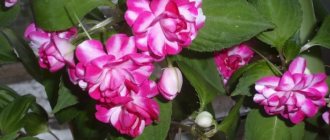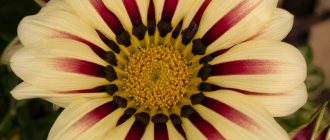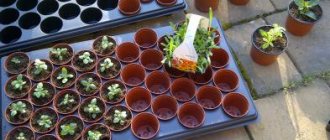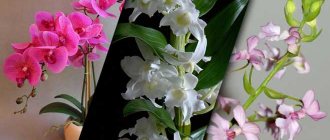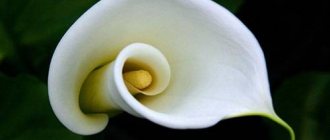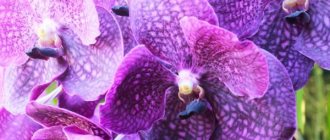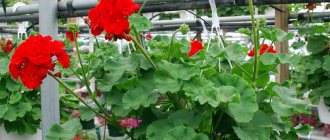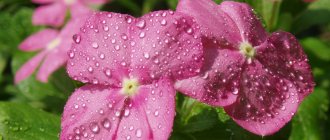The plant can be herbaceous or subshrub. Initially, balsam grew in the tropics; the supposed homeland of this flower is the island of Zanzibar. The flower appeared in Europe at the end of the sixteenth century, where cultivated varieties of balsam were bred.
With proper care, balsam blooms almost all year round.
The flowers of the plant are large and bright, most often red, but pink, yellow, orange, white, and burgundy are also found. There are varieties with two-color flowers, i.e., a contrasting “eye” in the center of the flower. The leaves are usually dark green, sometimes burgundy or variegated.
Advice!
The plant is moisture-loving and requires regular, frequent watering, especially in the warm season. In summer, the balsam should not be exposed to scorching sunlight; it is necessary to shade the plant. In winter, it is not recommended to heavily moisten the soil to avoid hypothermia. Drafts are also detrimental to the flower.
Impatiens do not need to create additional conditions; this flower feels great at the temperature and humidity of an ordinary living space.
Look at the photo of what the balsam looks like:
Planting seeds and cuttings
Planting balsam is done in two ways:
- .
It is considered a simpler way to plant a plant and is recommended for beginning gardeners who want to preserve the quality of the variety. For planting, cuttings obtained after spring pruning of the plant are used. The cut shoot is placed in water until roots appear, this happens after about 2 weeks.After this, the sprout is planted in sand or a substrate prepared from a mixture of peat and perlite in a 2:1 ratio. When the flower gets stronger, it is transplanted into a larger container with regular soil for adult plants.
- .
Used by experienced gardeners and, as a rule, for growing garden varieties. However, it can also be used for indoor plants. It is important to remember that balsam grown from seeds may not have the characteristics of the selected variety. For planting, seeds are placed on the surface of the substrate.It is allowed to slightly deepen the seed, but it is not advisable to sprinkle it on top. After this, the container is covered with film or a glass cap. After about 10 days, sprouts with two leaves appear. This means that the seedlings can be transplanted into separate pots.
You will learn all the details of plant propagation by cuttings and seeds by reading.
It is necessary to replant balsam in order to replace the old depleted soil with new and nutritious soil, as well as to provide additional space for root growth.
It is important to remember that some tightness is even beneficial for this flower.
, because balsam blooms only after the root system fills the space of the pot. If the container is too large, all the energy and nutrients of the balsam will go to the development of roots, and not to flowering.
Transplantation is carried out once a year - in spring, or twice a year - in spring and autumn, depending on the intensity of flower growth. It is also necessary to replant a plant purchased in a store 2 weeks after purchase - this is the time the plant needs to adapt to new conditions. Read about the intricacies of transplanting balsam and subsequent care for it.
Feeding and fertilizer
Feeding the plant is important during periods of flowering and active spring growth. In the spring, Vanka should be fed with mineral fertilizers. It is recommended to fertilize at least twice a month. For these purposes, you can purchase “uniflor-bud” or any other mixture of mineral fertilizers. Fertilizing can be applied simultaneously with watering or separately, at the root.
After transplanting, the plant must be fed. You can use mineral or nitrogen fertilizers. In winter, Vanka needs complex feeding, for example, a universal mixture - “Ideal”, mixtures for indoor flowering plants.
Required soil
This flower requires loose soil with low acidity. An excess of nutrients in the soil is not desirable, as it will lead to the growth of green mass and weak flowering. In a specialized store you can purchase an earthen mixture for flowering plants, or prepare the soil yourself:
- The first option for homemade soil is a mixture of leaf soil, turf, humus, sand and peat in a ratio of 2:2:2:2:1.
- A mixture of leaf soil with peat and river sand (2:1:1) is also used. It is important to remember that all components taken from the street must be disinfected.
Reference!
Despite the fact that balsam is very moisture-loving, a thin layer of drainage in the pot is still very desirable. They can serve as small pebbles or pebbles, laid in a layer of no more than 2-3 cm.
Soil selection
Balsam is not particularly picky about soil; for planting seedlings, you can purchase ordinary soil for indoor plants or growing seedlings.
If planting is carried out in the fall, or in the spring-summer period, then you can make the mixture yourself:
- Place small pebbles at the bottom of the pot for drainage and aeration of the roots;
- Then we prepare a planting mixture of 2 parts sand, 2 parts garden soil, 1 part distillation or peat, 3-5 tablespoons of wood ash;
- The resulting mixture must be treated with a manganese solution or scalded with boiling water;
- After treatment with boiling water, cool the mixture and keep it in the sun for a short time.
So, the mixture is ready for planting; additionally, after planting the seedling, the ground under it can be covered with small stones or special drainage stones can be used.
How to properly care?
It is extremely important for balsam to receive sufficient moisture.
In summer, the flower needs abundant watering, daily or every other day, depending on how quickly the top layer of soil in the pot dries out. Under no circumstances should the soil be allowed to dry out.
In winter, watering is reduced, especially if the plant is in a cool room. Usually, in the cold season, 2 waterings per week are enough for balsam.
Can I spray with water?
Spraying can be carried out if the air in the room is warm and dry.
In addition to additional hydration, this procedure serves as a prevention against the appearance of spider mites. Impatiens should be sprayed once every 2-3 days.
After spraying, it is necessary to keep the plant in the shade, since bright sunlight can burn wet leaves.
It is also important to avoid drafts to avoid hypothermia. For the same reason, it is not recommended to spray balsam in winter.
Top dressing
During flowering, balsam requires feeding.
Fertilizer should be applied once every 10 days from the beginning of spring to autumn, until the plant enters a dormant period, alternating nitrogen and phosphorus fertilizing. Among organic fertilizers, the main source of nitrogen is bone meal, and phosphorus is wormwood compost.
Nitrogen is necessary for balsam for the successful development of green mass, and phosphorus promotes high-quality flowering. Read about how to properly water and what to feed the plant for abundant flowering.
How to pinch?
To improve flowering and form a neat bush, in the spring it is necessary to pinch out the balsam, i.e., remove the upper part of the shoot.
Along with pinching, damaged leaves and wilted flowers are usually removed.
Thanks to this, the flower maintains a neat appearance, and also reduces the risk of certain diseases and pests.
Important to remember:
For dwarf varieties of balsam, pinching is not required.
Trimming
How to prune a plant correctly and when should it be done? Pruning is carried out in March, and young shoots of balsam are cut off, which can be used to propagate the flower. During pruning and pinching, it is necessary to increase watering so that the plant can more easily endure the painful procedures.
In order for a flower to develop well and bloom actively in the warm season, in winter it is necessary to provide it with a period of rest. This will help the plant rest and gain strength for spring. Receiving less sunlight, balsam can shed its leaves.
If proper care is taken, this phenomenon is not a cause for concern.
Lowering the temperature in winter is a desirable, but not necessary condition for balsam. If the plant is placed in cooler conditions during wintering, then you need to remember that the indicator should not be lower than +16 degrees. Watering is gradually reduced from daily to once every 3-4 days.
Accumulation of water in the pan is not allowed. Fertilizers are excluded completely or applied no more than once a month. Nitrogen and phosphorus fertilizers should be replaced with potassium-phosphorus fertilizers.
We wrote in more detail about growing and caring for balsam at home.
Appearance of balsam plants: photos of indoor plants and description
Potted flowers that you can buy in the store are usually perennial plants with thin and smooth stems, elongated oval leaves of a very rich light green or dark green color with splashes of purple. The stem can reach 35-50 cm, and the leaves located closer to the root can stretch into an oval with a diameter of up to 7-11 cm. The balsamaceae genus also has annual representatives.
This is what indoor balsam looks like - the photos were taken during the period of abundant flowering.
Annual representatives are grown in open ground. The care requirements will be the same.
Both types of plants can bloom both in inflorescences and single flowers, the petals of which have a characteristic bright color: snow-white, matte pink, scarlet, bright orange (fiery) and others.
The beauty of flowers in the unusual shape of the petals:
- freely located;
- fused in pairs;
- the presence in the inflorescence of one petal elongated into a spur;
- multicolor color: pink-burgundy, yellow-purple, white-violet and other shades;
- a white small bud opening with large, bright and rich petals.
The perennial species blooms profusely almost all year round. But only if caring for balsam at home was correct - the photo shows healthy plants from both subspecies. If an annual representative of the family is grown in a pot, then it will delight with large flowers in the summer. With good care, the flowering period is extended by 1-1.5.
Possible problems
When growing indoor balsam, you may encounter the following problems:
- The plant does not bloom, in most cases, due to unfavorable factors. Typically, flowering does not occur if the balsam is planted in a pot that is too large, does not receive enough water, or due to excess nitrogen, which it receives from fertilizers.
- Yellowing of the leaves is a signal of a lack of moisture in the soil. In addition, the leaves may turn yellow as a result of a burn if the flower is located in direct sunlight. In winter, this sign indicates hypothermia of the balsam.
Diseases and pests
Like many other indoor plants, balsam is susceptible to attack by pests and the appearance of. The following are considered the most common for this flower:
- Whitefly
- an insect dangerous to balsam, appearing in a dry, damp room that does not receive fresh air.Important!
For prevention, regular spraying and ventilation of the room with flowers is necessary. To get rid of whiteflies that have already appeared, use insect repellent tape.
- Spider mite
- feeds on the sap of balsam leaves, which causes the leaves to wither and curl. It appears, like the whitefly, when the flower is kept in the wrong conditions. Maintaining air humidity and good ventilation will help prevent the appearance of such a pest. - Soil mold
- occurs when there is excess moisture. Despite the fact that balsam is a moisture-loving plant, it is important to ensure that the soil does not sour. If the top part of the soil is still covered with mold, it is necessary to remove the affected layer of soil and fill in a new one.
Choosing a landing site
Impatiens, although a houseplant, feels great not only on window sills, but also in tubs, on the balcony, outside and fits perfectly into flower arrangements in flower beds. The main thing is to choose a good place for it and choose the right soil. Impatiens do not tolerate direct sunlight, but do not like strong shade. The best option for them is sun up to 12 o'clock and partial shade the rest of the daylight hours. Hills of terry balsams look beautiful in a combination of tall plants (roses, irises), against the background of subulate phlox, hosta, heuchera. They really look like bright lights when planted in the company of ground cover plants.
In tub culture, balsams do not react well to pot neighbors and prefer to grow on their own in the same container. The larger and wider the pot, the more luxurious the plant will be. If you plant a small rooted cutting in a hanging pot, then in a month you can already get a cascade of bright flowers.
It is important to know that the color saturation of the petals depends on the place where the plant is planted. In the floor shade, the flowers have a brighter color and give off a silvery tint. In strong sun, balsam inflorescences may not even bloom or lose their brightness and fade.
Moving the plant to open ground
Before transplanting a plant into open ground, you need to choose a suitable place for it , focusing on the following recommendations:
- Garden balsam is not picky in terms of choosing “neighbors”. Begonias, fuchsias, and verbena can be planted near it.
- You can get active growth and long flowering if you plant the crop on the western or eastern side.
- For balsam, moisture stagnation, constant dampness, frequent cold and drafts are not allowed.
- The soil should be loose, nutritious and with good drainage from expanded clay.
- The growth and development of the plant is negatively affected by heat and acidic soil. In such conditions, it stops blooming and the leaves fall off.
- Before planting, be sure to fertilize the soil with humus.
When all the preparatory activities have been completed, you can proceed to the actual planting :
- Thoroughly moisten the soil in which the seedlings are located. Do this 2-3 hours before landing.
- Make holes in the ground. Place them at a distance of 25-30 cm.
- Add fertilizer and water to each hole.
- Carefully remove the seedlings and transplant them into the prepared hole.
- Compact the soil around each plant and mulch using sawdust. Mulch is an excellent way to protect the soil from overheating and to retain moisture.
How to preserve balsam in winter
In the warm season, balsams do not require care. They only need to be protected from direct sunlight and provided with regular watering with warm water. Weekly fertilizing with complex fertilizers will increase the intensity of flowering, but if they are neglected, the plants will still be covered with flowers all season.
For a gardener, it is not so difficult to grow balsam from cuttings as to preserve it in winter. Potted flowers react especially painfully to changes in temperature. Only 50% of plants can adapt to indoor conditions after being outdoors.
A few tips will help keep losses to a minimum:
- Bring pots of flowers into the house when the room and street temperatures are still at the same level. Most often this happens at the end of August.
- Place plants in the house on the side on which the flower grew or was previously located.
- An open window will help the plant acclimatize faster.
- Reduce watering and fertilizing.
- Carry out morning and evening spraying.
- If the plant begins to shed its leaves, then you need to wait until the leaves fall and trim the tops. In a week, newer shoots will appear along the length of the branch.
Most gardeners agree that the best way to preserve the balsam variety is to take cuttings from the mother plant in early August and take the cuttings from the rejuvenated bush in February-March. This will protect the plant from many diseases, and the gardener from problems and dancing around the bush, which will try with all its might to release young cuttings in November-December.
Balsam propagation
Impatiens are propagated by cuttings and seeds. When cutting, young, healthy branches are cut from the bush with a sharp knife or blade and placed in a container with boiled, chilled water for several days, or the cut site is dried for 10-15 minutes and immediately planted in the soil. In the latter case, the planted cuttings are placed in a greenhouse, since balsams quickly lose the elasticity of the leaves and stem.
When propagated by seed, shoots emerge on the second or third day. It is important to maintain temperature conditions and normalize humidity so that the plant does not become infected with blackleg. After the appearance of the second true leaf, the young shoots are transferred to a separate container or planted in a permanent place.
Impatiens is a short-lived plant, but its beauty and rich flowering compels flower growers around the world to plant this miracle on their plots, balconies, and overcome all difficulties in order to preserve the desired variety.
Decorative flower “Vanka wet” or as it is also called Indoor balsam - care at home and its propagation is not difficult. But this floral fireworks can decorate the interior of any home with a lush bouquet of bright, picturesque flowers. All kinds of bud colors, depending on the type of indoor plant, with proper care will delight their owners with colorful flowers framed by lush green foliage all year round.
What is indoor balsam
The perennial or annual flower belongs to the Balsamaceae family. The bushy plant is distinguished by straight, succulent and fleshy shoots. On the stems, serrated, lanceolate or entire leaves without stipules are located in whorled or opposite order. Their color varies from green to reddish-bronze depending on the variety. The flowering period of "Impacts" continues from May until December inclusive.
The plant comes with smooth or double flowers, which can have a variety of colors in their collections: white, crimson, pink, red, lilac, yellow, orange, and also all kinds of shades of the listed palette. There are varieties of Balsam with an original combination of several colors of one flower (two-color). The fruits of the plant are multi-seeded capsules; touching them will cause them to crack.
Homeland of Balsam
“Vanka wet” comes from the island of Zanzibar, eastern India, southern China, Malaysia, so Balsam prefers subtropical and tropical climates. This origin explains the flower’s love for warmth, light, and abundant soil moisture. Balsam, brought to Europe in 1596 from Africa and Asia, quickly gained popularity among the local population.
In England, for its rich and long-lasting flowering, it was nicknamed “Business Lizzy”. From the Austrians, the flower miracle received the nickname “Beautiful Wreaths”. But “Vanka wet”, the plant began to be called for the crystals of sugar dew appearing on the edges of the leaves. Because of the instantly cracking seed pods, some call it from the Latin name Impatience simply “Touchy”, and also “Spark”.
Types of Balsams
Garden or indoor plant Impatiens has more than 500 varieties in nature. But in decorative floriculture, from 8 to 15 of the total number of varieties are actively cultivated. Lovers of blooming indoor flowers choose varieties of “Impatiens”, which are characterized by long and perennial flowering. And in addition, good survival in areas with a temperate climate.
A representative of the flora from the Balsam family is abundant in the following main groups:
- Waller's balsams combine a series of numerous hybrid varieties.
- Peters' balsam differs from its predecessor in larger dimensions.
- New Guinea balsam is an artificially bred variety. New Guinea hybrids tend to bloom indoors all year round.
Description
An adult plant reaches a height of 20 to 60 cm. The stem is soft green and translucent. There are both upright plants and hanging ones. The leaves are large, from 8 to 12 cm. Oval in shape with teeth on the edges. The plant blooms from May to December. Vanka flowers are located on flat corollas. They reach 4 cm in diameter. Usually, they do not have a strong smell. There are species with different shades: orange, pink, red, purple, white. Hybrids with double flowers have been bred. Impatiens with flowers collected in inflorescences are considered very beautiful.
Impatiens can be either an annual or a perennial plant.
Caring for Balsam at home
Among unpretentious indoor plants, “Touch-me-not” also occupies its niche. It is important to know what kind of care is required for Vanka wet at home and the peculiarities of cultivation. In order for an exotic flower to delight its owners with abundant blooms all year round, care involves providing the decorative flower’s basic needs for good health - partial shade and moisture.
There are several reasons why balsam sheds its leaves:
- Dry indoor air.
- Excessive or insufficient watering.
- Low or too high temperature in the habitat of an exotic houseplant.
Priming
Decorative indoor balsam - care at home includes providing the flower with fresh soil and substrates suitable for its variety. Cultivation should be carried out in a pot selected according to the size of the root system. Before planting “Vanka wet” in such a pot, you need to fill it with a nutrient mixture: black soil, moist soil, sand, peat, drainage. It is recommended to add humus to the substrate, because the plant prefers a moderate acidic environment.
Optimal temperature
Picturesque indoor balsam - care at home requires maintaining a moderate temperature and the absence of drafts. When keeping Balsam indoors, the winter temperature should be maintained in the range of 15-20 degrees. And in summer you can’t place the flower in the open rays of the sun. The sweltering heat has a detrimental effect on “Vanka wet”; it begins to dry out and wither. Comfortable temperature for Balsam from spring to autumn should not exceed +25 degrees.
Lighting
Impatiens are light-loving indoor plants; lack of lighting prevents their growth, the formation of buds, and in addition, their leaves turn yellow. But “Touchy” prefers partial shade to bright lighting. Exposure to direct sunlight is not recommended. Therefore, it is better to place Balsam on a windowsill facing north, east, southeast or west. If the indoor flower is located near the southern windows, then they should be shaded with any material, tracing paper or tulle.
Proper watering
The “Vanka wet” flower is moisture-loving, so the watering regime should be regular. Improper watering and lack of moisture immediately affects the plant, its foliage begins to wither and its flowers fall off. But over-watering can damage the root system. Excess moisture, especially with the onset of cold weather, leads to rotting of the root system.
It is recommended to spray the crown of a houseplant carefully, avoiding contact with flowers, and only at temperatures above 20 degrees. When it’s warm, Balsam is moistened more often, and water is poured so that the trays are slightly filled with it. In winter, watering should be less frequent, about once every two weeks. In the cold season, moderate humidity should be maintained as the soil dries, lightly adding water at room temperature.
Fertilizers
For lushly blooming indoor Impatiens, care at home is impossible without fertilizing the soil. When feeding “Touch-me-not”, it is better to use fertilizers of organic origin. In addition, it is allowed to use varieties of natural nitrogen fertilizers. Fertilizing is carried out twice during the warm season and once a month during the cool season.
Flower Wet Vanka: growing features
In total, botanists identify more than 600 species, including indoor balsam.
There are two large types of this plant: annual and perennial.
But, regardless of the type, there are several general rules for caring for Vanka:
- Vanka - wet flower - a name that did not arise by chance, but due to its moisture-loving nature. The flower needs regular watering, otherwise it stops blooming, and the leaves lose their freshness, brightness and healthy appearance. The lack of moisture is expressed in the fact that at first the bush becomes drooping, you can see how the stems literally lie down. You can also see how, after abundant watering, the plant comes to life right before your eyes, the leaves fill with juice, the ovaries of inflorescences form, and the stems acquire their former durability.
- Watering in winter can be reduced somewhat, but in the summer and spring months, especially during hot periods, it is better to overwater the bush rather than underwater it. It begins to wither quickly. In rooms where it is too hot, watering should be done every other day.
- Abundant flowering is ensured not only by fertilizing, but also by the small size of the pot. Experienced gardeners often plant indoor balsam in small plastic pots and seedlings, and then several of these pots are placed in a rectangular flower tray. To make such a composition decorative, tow or a stone-sand mixture is used. The latter provides drainage, moisture retention and aeration. For decorative purposes, the composition is formed from balsam with inflorescences of different colors.
- Flowering is also directly dependent on the quality of pruning and lighting.
- Impatiens are light-loving; in the shade the plant continues to grow, but with less intensity, and flowering is significantly reduced and is short-lived.
The general principle of caring for plants is their regular feeding. Vanka is not particularly picky about it, but the use of mixtures for indoor flowers, such as “Ideal,” improves the appearance of the color and also improves flowering. Let's take a closer look at the intricacies of caring for balsam.
Balsam Reproduction
The touch-me-not flower is very easy to grow yourself. Balsam is propagated by several methods:
- Propagation by seeds.
- Propagation by cuttings.
To propagate by seeds, they need to be sown in moist soil and covered with film, creating a greenhouse atmosphere. Propagation through apical cuttings is a faster method. The propagation method using cuttings involves cutting beautifully formed and healthy shoots from a bush, which are kept in a humid environment until roots appear.
How to root Balsam
This exotic houseplant has the peculiarity of rooting - it blooms better in cramped pots. If you plant "Impatis" in a spacious container, it will devote a lot of effort to the growth of roots throughout the entire territory of the pot and the flowers will not appear soon. Therefore, to accelerate the growth of the above-ground part of the “Impatis” and the rapid start of vigorous flowering, you must initially plant it in a small pot. And as they grow, select a larger container - the plants can easily tolerate transplants no more often than annually.
Diseases and pests of Balsam
Due to the hybridization of some Impatiens varieties, they are very susceptible to disease. The leaves of indoor plants require special attention. If you look at even one damaged shoot, this may be followed by the death of the entire plant. And if you manage to save Balsam from the disease, then it will lose its decorative effect. You should also be wary of the appearance of pests on the above-ground parts of a houseplant.
You will need to carefully inspect the flower from time to time - balsam is damaged by whiteflies and aphids. And the presence of spider mites, which settle in the internodes on the stems, is most dangerous for “Vanka mokrogo”. A sign of the disease is cobwebs on the leaves (spider mites). In the case of whitefly, the disease is identified by white spots on the leaves and their slight curling. Aphids are recognized by brown marks and deformation of the leaves.
Treatment
Delicate indoor balsam - growing and caring for it at home is rarely complete without the preventative and healing measures of the flower. To resist pests of an exotic plant, it is recommended to carefully inspect its above-ground part before watering. If traces of spider mites, whiteflies, or aphids are found, treat the “Impatis” with appropriate medicinal agents.
